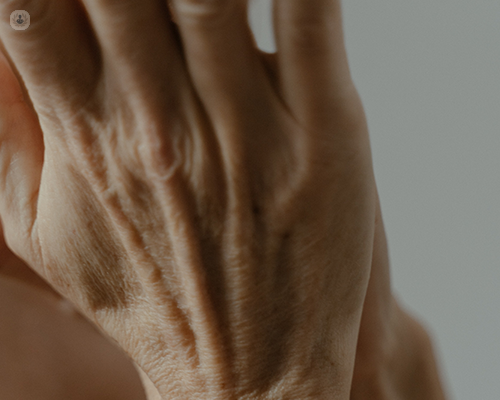Rheumatoid arthritis: Understanding the treatment options available
Written by:Rheumatoid arthritis is a chronic condition in which your own immune system attacks the cells that mark your joints by mistake, causing swelling, stiffness and pain. Hands, feet and wrists are usually affected, but other tissues can also be involved. If you’re experiencing repeated symptoms of inflammation, fever, or pain, you might need to visit an expert.
In this article, highly distinguished rheumatologist, Dr Joel David, provides a comprehensive view of rheumatoid arthritis. He details what are the most effective clinical (and home remedy) treatments for rheumatoid arthritis, when you should seek immediate help, and how you can differentiate rheumatoid arthritis from other types of arthritis, such as osteoarthritis.

In relation to rheumatoid arthritis, what joints are most commonly affected?
Perhaps the wrists are the most common. Most people who have rheumatoid arthritis will have symmetrical disease, which means that it affects both sides equally, and the wrists and the knuckles are probably the commonest. Rheumatoid does not affect the end joints of the fingers. Given that it’s a symmetrical disease, and the feet often mirror the hands, the ball of the foot is also commonly involved. Large joints, such as shoulders, knees, and hips, can also be affected, perhaps slightly less commonly on first presentation.
What are the most effective methods of treating rheumatoid arthritis?
Rheumatoid arthritis is an autoimmune disease, which can potentially be destructive to the joints. It is a systemic disease, which means that it not only affects the joints, but may also affect the eyes, lungs, heart or kidneys. Therefore, if there is evidence of this, the disease needs to be treated fairly aggressively: rheumatologists will talk about ‘a window of opportunity’.
Once the diagnosis is made, there will be symptomatic treatment for the pain, but then there needs to be a ‘damping down’ of the overactive immune system. This could mean using steroids initially. Steroids however, will not be appropriate for long-term maintenance; they are only used here as induction therapy.
When it comes to the overactive immune system, immunomodulatory therapies, of which the commonest is methotrexate, will be needed. Other drugs include leflunomide and sulfasalazine. When these don’t work, are proved ineffective, or have side effects, then there is a whole range of newer drugs, which we call the biological drugs. The criteria for biologics use has recently been lowered and they could be used earlier in treatment algorithm than before. Another group of drugs called the small molecules or JAK inhibitors are oral preparations and have been shown to be very effective.
Surgery, which used to be a treatment for rheumatoid in the old days, has much less relevance now.
What are some useful and effective home remedies to help treat the condition?
Many people ask this, but the difficulty with home remedies or complementary therapies is that they have not undergone the same scientific scrutiny as conventional pharmacotherapy. So, when you ask what are the proven remedies, there probably are none.
However, there is large experience and anecdotes of their value. Simple mechanical measures such as ice, rest, and massage are helpful. Acupuncture (may be useful for pain relief), evening primrose oil, and ginger are commonly tried. There is little evidence for turmeric, but some people can find it effective. Cannabis oil – hemp oil – is another one which has gained a lot of interest. There is no scientific evidence for this at the dosages available over the counter, but some people will find they relieve muscle spasms, stress, and improve pain control. I think it’s important for rheumatologists to be open to discussion with their patients on the use of complementary therapies.
Why does rheumatoid arthritis occur and what causes it?
Nobody knows why. What we do know, though, is that it is an autoimmune disease and that it has a genetically driven. Rheumatoid arthritis has the same genetics as other autoimmune diseases like autoimmune thyroid disease, polymyalgia, and pernicious anaemia, but it may be precipitated by an environmental factor which we haven’t properly identified yet – perhaps a virus, major stress, or trauma such as bereavement etc.
When should immediate medical attention be sought?
As soon as the patient becomes aware of pain, stiffness, swelling and they have had blood tests which support active inflammation (the CRP level is elevated), regardless of a rheumatoid factor or a positive anti-CCP, they should be referred to a rheumatologist.
A known rheumatoid patient who develops evidence of systemic disease such as fever, weight loss, shortness of breath, cough, palpitations, eye inflammation… all of these would be considered red flags and need urgent investigation.
Also, any evidence of infection - a rheumatoid patient you may be more susceptible to infection due to the drugs or the immune system not functioning well, so immediate attention is required.
People often become anxious about the treatment of rheumatoid: although the drugs modulate the immune system, they don’t necessarily make one vulnerable to multiple common infections. A rheumatoid patient needs to take precautions – such as one would do for COVID - but they shouldn’t necessarily think of themselves as being majorly immunocompromised.
What is the main difference between osteoarthritis and rheumatoid arthritis?
The main differences are that there is no inflammation present in osteoarthritis, the patient is not unwell and the distribution of joint involvement is different.
Osteoarthritis, which is also called ‘wear and tear arthritis’ or degenerative joint disease, is different in the sense that it maybe an age-related phenomenon or a post joint trauma. Although rheumatoid arthritis can peak in the thirties to fifties, it can essentially occur at any age, even in children (JIA).
Osteoarthritis, when it affects the hands, usually also affects the base of the thumb, the ends of the fingers – the DIP joints – and large joints such as hips and knees. It is treated with exercise or physiotherapy, analgesia, and does not respond to the treatments that rheumatoid responds to. Sometimes intraarticular steroid can be helpful, and ultimately, if the joint is very damaged, it maybe amenable to surgical correction. There are also complementary therapies that some people use for osteoarthritis such as glucosamine and chondroitin that don’t help with rheumatoid. Interestingly, osteoarthritis of the hands can be more genetically associated than rheumatoid.
Dr Joel David is a leading rheumatologist based in Oxford and London, who specialises in rheumatoid, psoriatic, and juvenile arthritis, ankylosing spondylitis, lupus, and gout, among other conditions. If you’re worried about your rheumatoid arthritis and would like to discuss available treatments, don’t hesitate to visit Dr David’s Top Doctors profile today.


